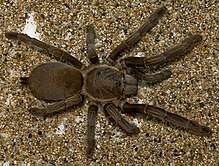Selenocosmia crassipes
Selenocosmia crassipes, synonym Phlogius crassipes, also known as the "Queensland whistling tarantula" (or "barking spider") is a species of tarantula native to the east coast of Queensland, Australia. The name "whistling tarantula" comes from its ability to produce a hissing noise when provoked, a trait it shares with other Australian theraphosids.[2] This hissing is produced by the spider stridulating a patch of setae associated with its chelicerae. It has also been called the "eastern tarantula".[3] The species name crassipes is Latin for "fat leg" referring to the relatively fat front legs.
| Queensland whistling tarantula | |
|---|---|
 | |
| Scientific classification | |
| Kingdom: | Animalia |
| Phylum: | Arthropoda |
| Subphylum: | Chelicerata |
| Class: | Arachnida |
| Order: | Araneae |
| Infraorder: | Mygalomorphae |
| Family: | Theraphosidae |
| Genus: | Selenocosmia |
| Species: | S. crassipes |
| Binomial name | |
| Selenocosmia crassipes (L. Koch, 1874) | |
| Synonyms[1] | |
| |
Selenocosmia crassipes can attain legspans of up to 22 cm (8.7 in). Its body length, from eyes to the rear of its abdomen, measures between 6 and 9 cm (2.4 and 3.5 in), making it the largest Australian tarantula.
Description
The thick footed tarantula has powerful long venomous fangs that can grow up to 1 centimetre (0.39 in) long. Its body is 6 centimetres (2.4 in) with a leg span of 16 centimetres (6.3 in) or larger than the size of man's hand. Identification is relatively simple as this very large spider has thicker front legs than back legs.[2] It is recognized as the largest spider in Australia.[3] Due to the hissing sound the spider makes when approached, it has acquired the nickname "barking spider", sometimes “hissing spider”.[4][5] This species is quite shy and normally does not wander far from its burrow.[6] Females live up to thirty years, males up to eight years.[7]
Venom
The bite from an Eastern tarantula is not fatal to a human, but can cause up to six hours of vomiting. The venom can cause death to a dog or cat within thirty minutes.[3][8]
In May 2010 a scientist living near Cooktown, Queensland, was bitten on her right index finger and experienced symptoms never reported before in research literature. The finger became swollen and very sensitive to touch within one hour. "The pain was so intense that sleep that night was impossible. Fifteen hours post-bite, the adjoining finger and upper hand were also swollen and painful." The pain and swelling were limited to the hand and lower arm only (and not systemic as previously reported) and she reported that they had both eased after 26 hours. Photos were taken at various stages of the swelling.[9]
Food
Despite the sometimes used common names bird-eating spider and bird spider, this nocturnal ground dwelling species is not likely to ever encounter or feed on birds. These spiders predominately feed upon invertebrates including insects and other spiders. Small vertebrates such as geckos, skinks and frogs are also part of the diet.
Taxonomy
Selenocosmia crassipes was first described by Ludwig Koch in 1874, as Phrictus crassipes. It was subsequently transferred to Phlogius by Simon in 1887 and then to Selenocosmia by the Australian arachnologist Barbara York Main in 1982. In 1995, Günter Schmidt transferred the species back to the genus Phlogius. This transfer is not accepted by the World Spider Catalog, which does not recognize the genus Phlogius.[1]
Distribution and habitat
Selenocosmia crassipes is found throughout North Queensland and is a burrowing arachnid, living underground in burrows, which can be up to 1 metre (3.3 ft) deep, but might be forced into the open during periods of heavy rain.[3] Young spiders find natural burrows under rocks or roots. Adults expand their burrows up to 2 metres (6.6 ft) lined with silk with a tunnel off the main tunnel going upwards to a chamber with an air pocket sufficient to last a few days. It lives in rainforests and gullies or other sheltered cooler spots in open forests along the Queensland Central coast. [10] It is also found in and around gardens or other plant life.[6]
As a pet
Selenocosmia crassipes is a fast-growing spider and widely sought after as a pet. It is harvested from the wild, often illegally, a threat to its natural population.[11]
References
- "Taxon details Selenocosmia crassipes (L. Koch, 1874)", World Spider Catalog, Natural History Museum Bern, retrieved 2018-06-01
- "Tarantula or Whistling Spiders". Queensland Museum. Retrieved 23 March 2014.
- Townsville Bulletin: Spider invasion in Bowen Archived October 6, 2009, at the Wayback Machine
- Times Online: Giant spiders invade Australian Outback town
- Brisbane Times: Web of lies: UK press plays up spider 'invasion'
- News.com.au: Giant bird-eating spiders invade town
- SkyNews: Tarantulas Spin Web Of Terror In Oz Town
- Queensland Museum (2000), p. 40.
- Raven and Covacevich (2012), pp. 19-22.
- "Tarantulas Spin Web Of Terror In Oz Town". Sky News. 20 May 2009. Retrieved 23 March 2014.
- Science, jurisdiction=Queensland; sector=government; corporateName=Department of Environment and (2006-08-29). "Tarantulas". Department of Environment and Science. Retrieved 2019-02-12.